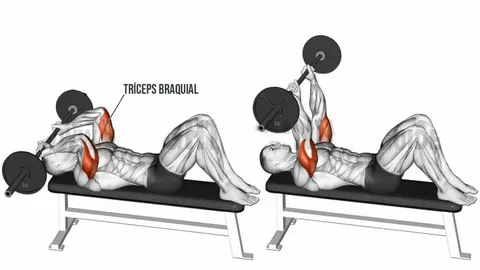Have you ever heard of a cooler-sounding exercise than the notorious scull crusher? Of course not, because nothing can beat feeling like a warrior and bragging about skull-crushing twice per week. This is a single-joint exercise that powerfully targets your triceps while also activating your shoulders and traps, and it can be done with many types of equipment, yet many guys fail to see its impressive mass-building potential.
As with anything else, your gains will depend on the way you perform it, and by making a few simple tweaks you can greatly increase the effectiveness of this exercise – in fact, transform it into a move that will accelerate your triceps development beyond your imagination! Learn all about it in the article below.
How to Do Skull Crushers: The Basics
The most common skull crusher variant is performed by lying on a flat bench and holding a weight with two hands above the forehead. That being said, skull crushers can be done using a variety of tools: dumbbells, a barbell, an EZ curl bar, or an elastic band. The weight is lowered in a slow and controlled manner until it lightly touches the forehead, then explosively pushed upward to a lockout position.

This way of performing skull crushers allows your arms to remain perpendicular to your body, thereby recruiting muscle fibers from all three triceps’ heads.
Two Skull Crusher Variations
Although this exercise can undoubtedly produce significant results, there are other ways to do skull crushers that can add variety in your workout and boost your gains even further. Namely, by keeping your hands by your sides you can cause greater lateral-head activation, while moving the arms overhead simulates more of the long head fibers.
Decline Skull Crushers
Using a decline bench for skull crushers is a great alternative to the classic version of the exercise, considering that by opening the degree of bend in the elbows it increases the range of motion and trains the triceps in a manner that places stress on each insertion point. Also, many people feel like this decline skull crushers are easier on their elbow joints.

Once you position yourself on the bench, secure your legs and grab the bar with a close grip. Lift it from the rack and hold it straight over you so that it’s perpendicular to the floor. Lock your arms and keep your elbows in. As you inhale, bring the bar down by moving your forearms in a semicircular motion towards you until the bar lightly touches your forehead. As you exhale, squeeze your tri’s and lift the bar back up.
Incline Skull Crushers
Contrary to decline skull crushers, incline skull crushers require you to close up the degree of bend in your elbows and move your arms closer to an overhead position, thereby accentuating long-head engagement. However, the incline shouldn’t be too steep, or otherwise this will take a big part of the resistance off your triceps.

Set up an incline bench and grab a barbell with an overhand grip. Keeping your elbows in and arms fully extended, inhale and lift the bar overhead, positioning your arms in line with your torso above the head; then slowly lower it in a semicircular motion behind your head. Exhale, squeeze your triceps and push the bar back up.
One of the most important benefits of doing skull crushers on an incline or a decline bench is that these angles reduce elbow pain. As any other open chain exercise, skull crushers tend to cause elbow pain because of the large lever, and this the main reason some people avoid them at all costs. However, it’s also true that most people don’t even know how to do skull crushers correctly, which places them at greater risk of injury.
Important Tips
• Don’t raise your hips off the bad and don’t use momentum to lift the bar, as this will increase your risk of injury while minimizing the effectiveness of the exercise.
• If you experience wrist pain when using a regular straight bar, replace it with an EZ bar, as the latter places less stress on the wrists.
• Although using a decline or an incline bench and paying close attention to your form at each workout will greatly reduce your risk of elbow pain, this issue usually can’t be completely avoided, so you shouldn’t do skull crushers regularly for too long or too often.
• If you find yourself constantly flaring your elbows to complete movement then the weight you’ve chosen is too heavy – reduce it and try to keep your elbows in.
• For best results, keep your reps in the high range and make sure to complete a full-range of motion at each rep.
• Your triceps need varied stimuli in order to grow, so consider switching to dumbbells once in a while. Having each arm work independently requires a greater deal of stabilization and will help you overcome any strength imbalances between your arms.
Start experimenting with decline and incline skull crushers and watch your triceps grow! Good luck!

